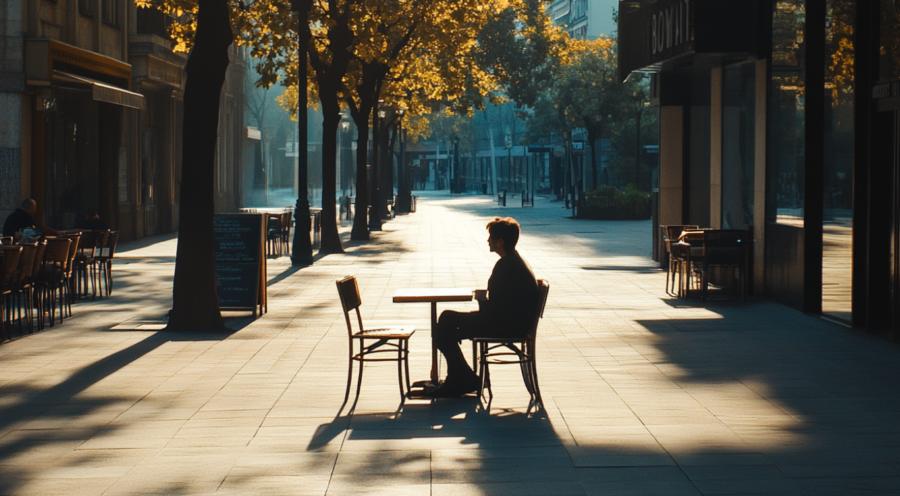Negative space—those areas of emptiness surrounding your main subject—acts like a reserved, slightly awkward character at a party who still manages to dominate the room. It shapes narrative by forcing the viewer to lean in, to interpret, to fill the silence with their own meaning. And in storytelling photography, meaning is the best currency there is.
Why Emptiness Speaks Louder
Imagine a portrait of someone standing alone in a doorway. If the frame is packed tight—every inch crammed with detail—you’ve given the viewer all the information. There’s nowhere for the mind to wander. But leave space around them—quiet space, even awkward space—and the photograph starts muttering private thoughts. Suddenly the viewer wonders whether the person is waiting for someone. Or leaving someone. Or hiding from the landlord.Negative space is narrative tension. It creates the visual equivalent of an unfinished sentence. For an image to be compelling, the audience must be invited in, not force-fed the whole plot.
The Emotional Weight Of Nothing
At first, emptiness seems like a strange thing to rely on. People generally avoid emptiness—empty inboxes, empty fridges, empty dating apps. But in photography, emptiness allows your subject to breathe. It isolates emotion and gives it legroom.Some images need to feel sparse, almost lonely. Others use negative space to create scale or awe. If your subject is tiny in a sea of open sky, you’ve just explained insignificance, yearning, isolation—without photographing a single tear or twitching eyebrow. The surrounding space becomes a silent chorus, singing its own story.
How To Use Nothing Intentionally
Negative space isn’t about emptying your frame like a minimalist trying to impress a monk. It’s about intention. Ask yourself what the space is doing for the story. If it doesn’t contribute, you’re not using negative space—you’re just standing too far back.- Place your subject off-center and let the emptiness pull the eye toward them.
- Use blank walls, sky, water, or shadow to guide attention and emotion.
- Let silence exist—don’t cram the frame with more just because it’s there.
Let The Viewer Do Some Work
When you leave space, something curious happens: the viewer becomes active. They start constructing backstories. They begin to wonder what lies just beyond the frame. A photo of a person staring out of a window becomes a miniature mystery—an unspoken narrative waiting to be completed. When everything is spelled out visually, the viewer becomes passive. But show restraint, and suddenly they have questions, theories, sometimes elaborate psychological analyses that would make a therapist weep with envy.A storytelling image is not a documentary of facts. It’s an invitation to think. Negative space turns a photograph into a whisper rather than a shout, and whispers are far more intriguing.
The Discipline Of Leaving Things Out
The hardest part of using negative space is resisting the urge to clutter. Cameras tempt us to capture everything. The brain tempts us to justify every millimeter of the frame. And modern life tempts us to add more—because more feels productive.Yet, the best storytelling photographers behave like editors. They cut, refine, remove. They ask a deceptively difficult question: *What can I exclude?*
This can feel uncomfortable. The world teaches us to accumulate—proof, achievements, photos of brunch. Negative space pushes against that instinct. It says, “Relax. Let the emptiness talk.”
If the subject feels too tiny in the frame, don’t panic. Lean into that smallness. Let the space around them imply everything they aren’t saying. Not every story needs a marching band.
When Nothing Becomes The Main Character
Here’s a strange truth: sometimes the background tells the emotional story better than the subject. A lone figure on a bench can be poignant, but a lone figure dwarfed by negative space becomes cinematic. The emptiness gives context to their solitude.Negative space also affects pacing. It slows the viewer down. In a world where scrolling is furious and attention spans are basically caffeinated squirrels, space acts like a hand on the shoulder, saying, “Stay here a moment. Look.”
If a viewer lingers, even for an extra heartbeat, the story has succeeded.
Less Is More Than Enough
We tend to think our job is to reveal everything. But stories aren’t powerful because of what they show—they’re powerful because of what they imply.Let the frame breathe.
Let the silence do its job.
Let the viewer wander in the gaps.
In photography, emptiness isn’t absence. It’s intention. It’s narrative. It’s the moment waiting to be realised. When used deliberately, negative space becomes the quiet force that shapes emotion and invites interpretation.
Thanks For The Space
Negative space isn’t nothing—it’s the room where imagination stretches its legs. And when that happens, your photographs stop being flat rectangles and start becoming emotional territories. The areas you leave empty are where the story grows, where feeling forms, where the viewer steps inside and makes the moment theirs.Give your images space. They’ll return the favour.
Article kindly provided by leecharltonphotography.com

